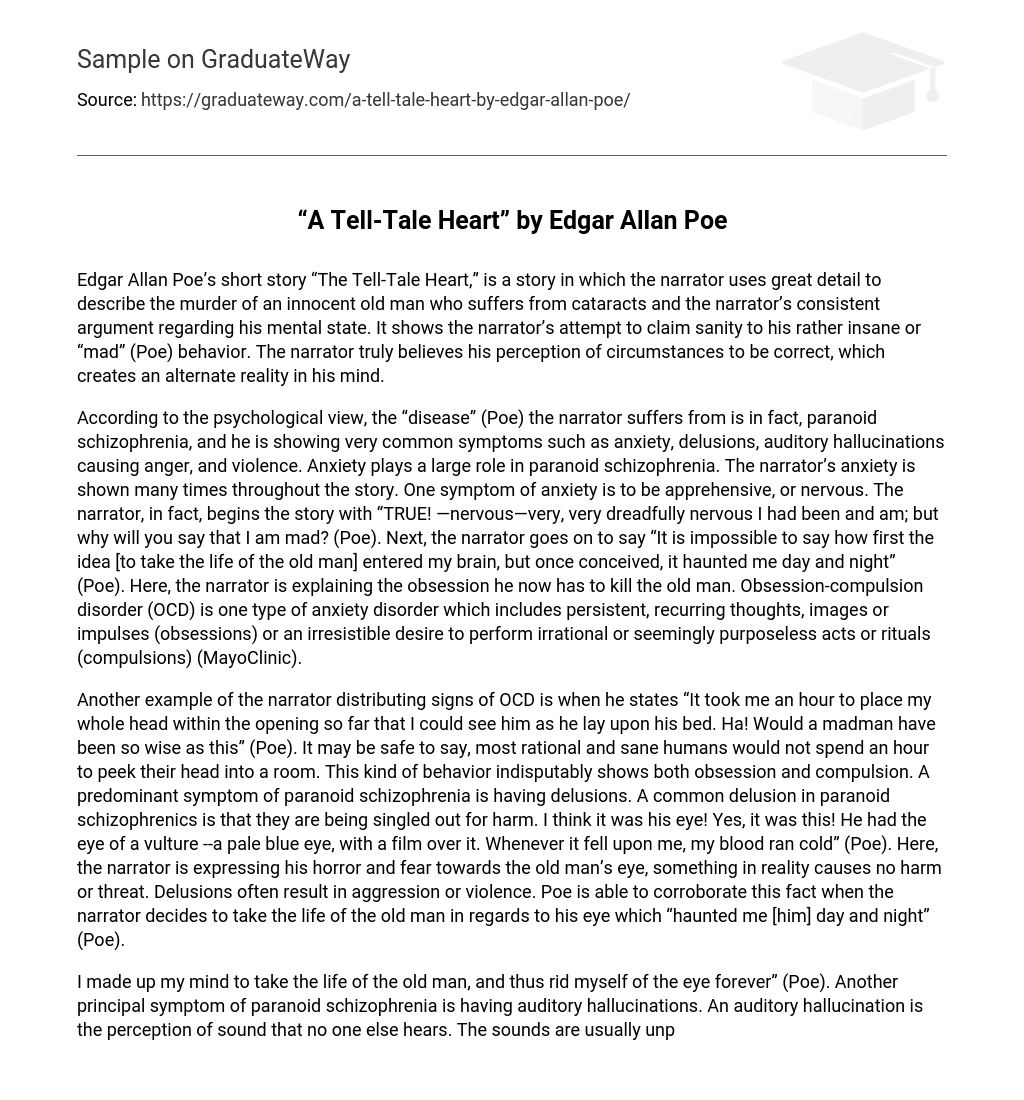Edgar Allan Poe’s short story “The Tell-Tale Heart,” is a story in which the narrator uses great detail to describe the murder of an innocent old man who suffers from cataracts and the narrator’s consistent argument regarding his mental state. It shows the narrator’s attempt to claim sanity to his rather insane or “mad” (Poe) behavior. The narrator truly believes his perception of circumstances to be correct, which creates an alternate reality in his mind.
According to the psychological view, the “disease” (Poe) the narrator suffers from is in fact, paranoid schizophrenia, and he is showing very common symptoms such as anxiety, delusions, auditory hallucinations causing anger, and violence. Anxiety plays a large role in paranoid schizophrenia. The narrator’s anxiety is shown many times throughout the story. One symptom of anxiety is to be apprehensive, or nervous. The narrator, in fact, begins the story with “TRUE! —nervous—very, very dreadfully nervous I had been and am; but why will you say that I am mad? (Poe). Next, the narrator goes on to say “It is impossible to say how first the idea [to take the life of the old man] entered my brain, but once conceived, it haunted me day and night” (Poe). Here, the narrator is explaining the obsession he now has to kill the old man. Obsession-compulsion disorder (OCD) is one type of anxiety disorder which includes persistent, recurring thoughts, images or impulses (obsessions) or an irresistible desire to perform irrational or seemingly purposeless acts or rituals (compulsions) (MayoClinic).
Another example of the narrator distributing signs of OCD is when he states “It took me an hour to place my whole head within the opening so far that I could see him as he lay upon his bed. Ha! Would a madman have been so wise as this” (Poe). It may be safe to say, most rational and sane humans would not spend an hour to peek their head into a room. This kind of behavior indisputably shows both obsession and compulsion. A predominant symptom of paranoid schizophrenia is having delusions. A common delusion in paranoid schizophrenics is that they are being singled out for harm. I think it was his eye! Yes, it was this! He had the eye of a vulture –a pale blue eye, with a film over it. Whenever it fell upon me, my blood ran cold” (Poe). Here, the narrator is expressing his horror and fear towards the old man’s eye, something in reality causes no harm or threat. Delusions often result in aggression or violence. Poe is able to corroborate this fact when the narrator decides to take the life of the old man in regards to his eye which “haunted me [him] day and night” (Poe).
I made up my mind to take the life of the old man, and thus rid myself of the eye forever” (Poe). Another principal symptom of paranoid schizophrenia is having auditory hallucinations. An auditory hallucination is the perception of sound that no one else hears. The sounds are usually unpleasant. (MayoClinic) The narrator tells the reader “The disease has sharpened my senses –not destroyed –not dulled them. Above all was the sense of hearing acute” (Poe).
Here, Poe may be subtlety implying the reader of a mental “disease” in which the narrator believes he is hearing sounds, rather than some kind of physical illness in which his sense of hearing is actually heightened. Poe makes the mental “disease” aspect more apparent to the reader when the narrator says “I heard all things in the heaven and in the earth. I heard many things in hell” (Poe). As the reader, it is obvious that a human being cannot hear all things in heaven, hell, and in the earth.
Also, some auditory hallucinations may make ongoing criticisms of what one’s thinking or doing, or make cruel comments about one’s real or imagined faults. (MayoClinic) Poe gives a great example of this when the narrator shouts to himself, “Almighty God! –no, no! They heard! –they suspected! –they knew! –they were making a mockery of my horror! ” (Poe). Poe shows the reader that the police, to which the narrator was referring, heard nothing, suspected nothing, knew nothing, and were not mocking his horror in anyway. And still the men chatted pleasantly, and smiled” (Poe). Violence, another prominent symptom of paranoid schizophrenia, is a significant part of the story. “First of all, I dismembered the corpse. I cut off the head and the arms and the legs. ” (Poe). Some may say it takes a very violent human being to dismember and decapitate another. The narrator also gets violent at the end of the story. “I swung the chair upon which I had been sitting, and grated it upon the boards, but the noise arose all over and continually increased” (Poe).
In conclusion, the Diagnostic and Statistical Manual of Mental Disorders (DSM), a manual published by the American Psychiatric Association, is used by mental health providers to diagnose mental conditions. According to the DSM, diagnostic criteria for paranoid schizophrenia include the following: a preoccupation with one or more delusions, and frequent auditory hallucinations (MayoClinic). With the narrator clearly showing many symptoms of paranoid schizophrenia, including both those in which the DSM uses to diagnose the illness, it is safe to say the narrator, is in fact, a paranoid schizophrenic.
Works Cited
“Diseases and Conditions.” MayoClinic. Mayo Foundation for Medical Education and Research, n.d. Web. 24 Feb. 2013. Poe, Edgar A. “A Tell Tale Heart.” Classic Short Stories. N.p., n.d. Web. 24 Feb. 2013.





